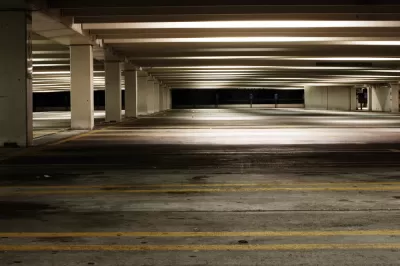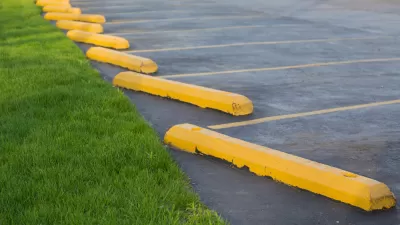In cities big and small, the tide is turning against sprawling parking lots, car-centric development, and minimum parking mandates.

American cities, designed for decades to accommodate private cars, are starting to see the benefits of reducing the amount of land used for parking and supporting other transportation modes.
According to an article by Jane Margolies in The New York Times, “The United States has about two billion parking spots, according to some estimates — nearly seven for every car. In some cities, as much as 14 percent of land area is covered with the black asphalt that engulfs malls, apartment buildings and commercial strips.” But today, as housing costs rise, housing supply fails to keep up with demand, and the negative impacts of sprawl and carbon emissions are more broadly understood, minimum parking requirements—mandates that dictate how much parking a developer must provide for a project based on the project’s use, and that often call for more parking than actually needed—are being revised or eliminated in cities and states around the country. Shifting work patterns are also reducing the need for parking in some areas, making it a good time for cities to evaluate the need for parking mandates.
Margolies outlines the history of off-street parking in the U.S., which correlates with the rise of private car ownership. “In the postwar period, when Americans were in thrall with the automobile and the federal government unfurled highways across the land, parking minimums were enshrined in zoning codes to ensure that Americans would always find a paved parallelogram waiting for them at the end of their trip.” Margolies explains that these mandates were not based on any real calculation of need, but became enshrined in the zoning codes of most cities.
Aside from promoting car ownership and inducing sprawl, parking requirements also drive up the cost of development. “Even a basic, stand-alone parking structure costs nearly $28,000 per spot on average, not including land, said Rob McConnell, a vice president at WGI, an engineering firm.” Parking reform advocates like University of California, Los Angeles (UCLA) professor Donald Shoup have spent decades arguing that parking policy has a major impact on housing and transportation costs, urban design, mobility, walkability, and quality of life.
Margolies highlights the success of the first major U.S. parking reform program in Buffalo, New York, where “A 2021 study revealed that after the repeal, new major developments overall had 21 percent fewer spaces than the minimum parking mandates would have required.” Other reforms followed at local and state levels, signaling a growing movement to reimagine how parking fits into cities.
FULL STORY: Awash in Asphalt, Cities Rethink Their Parking Needs

Alabama: Trump Terminates Settlements for Black Communities Harmed By Raw Sewage
Trump deemed the landmark civil rights agreement “illegal DEI and environmental justice policy.”

Planetizen Federal Action Tracker
A weekly monitor of how Trump’s orders and actions are impacting planners and planning in America.

The 120 Year Old Tiny Home Villages That Sheltered San Francisco’s Earthquake Refugees
More than a century ago, San Francisco mobilized to house thousands of residents displaced by the 1906 earthquake. Could their strategy offer a model for the present?

Ken Jennings Launches Transit Web Series
The Jeopardy champ wants you to ride public transit.

BLM To Rescind Public Lands Rule
The change will downgrade conservation, once again putting federal land at risk for mining and other extractive uses.

Indy Neighborhood Group Builds Temporary Multi-Use Path
Community members, aided in part by funding from the city, repurposed a vehicle lane to create a protected bike and pedestrian path for the summer season.
Urban Design for Planners 1: Software Tools
This six-course series explores essential urban design concepts using open source software and equips planners with the tools they need to participate fully in the urban design process.
Planning for Universal Design
Learn the tools for implementing Universal Design in planning regulations.
Clanton & Associates, Inc.
Jessamine County Fiscal Court
Institute for Housing and Urban Development Studies (IHS)
City of Grandview
Harvard GSD Executive Education
Toledo-Lucas County Plan Commissions
Salt Lake City
NYU Wagner Graduate School of Public Service





























